Equipment
Veydra Cine Mini Prime MTF Optical Bench Tests
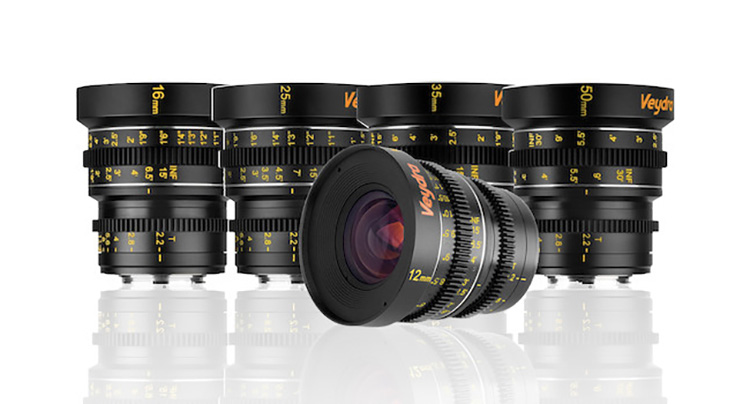
I have my preconceived notions, just like anyone else. A long while back the video techs told me we were stocking Veydra Primes in multiple focal lengths for m4/3 mounts. I just rolled my eyes and passed on by. Another boutique lens that would have poor resolution, ridiculous copy-to-copy variation, and a shelf-life-until-broken measured in weeks. Not interested.
But I noticed we were stocking more and more of them because they rented well; and added them in E-mount, too. I also saw they rarely came to repair. Then I did a little checking and found that our techs, who can check out any gear they want for their weekend shoots (it is an excellent perk, isn’t it?) were taking Veydras home pretty often. So I figured it was time to test them.
For those of you who don’t follow this blog, this is not a lens review. There are plenty of places to find that. This is the results of optically testing multiple copies. It won’t tell you a thing about how it focus breathes, how it handles, or whether it has that ‘film’ look. I will simply tell you how well it resolves (because you can roll your artsy eyes all you want; sometimes you have to make things look sharp), and about sample variation.
If you haven’t seen Veydra lenses, they are very small. They’re the Corgi’s in the Kennel of Cinema Lenses; they have all the features of the big dogs, but you think ‘really cute’ instead of ‘scare away burglars.’ Actually, maybe that’s a bad analogy, because Corgi’s cost as much as the big dogs, but Veydra’s are way cheaper than most Cine Primes. You can buy a set of these for what one nice Zeiss CP.3 lens would cost. On the other hand, like a Corgi’s short legs, the Veydras won’t cover a full-frame sensor; they’re either m4/3 or Super 35 image size and come in m4/3 and Sony E mounts.
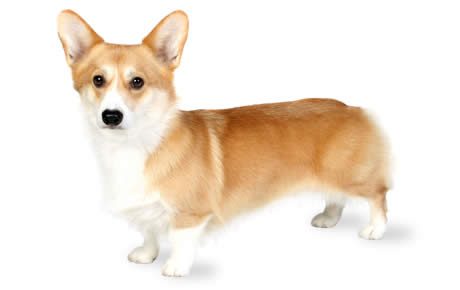
http://dogtime.com/dog-breeds/pembroke-welsh-corgi#/slide/1
In this post I’ll look at the three standard-to-telephoto- range lenses; Veydra 35mm T2.2 Mini Prime; Veydra 50mm T2.2 Mini Prime; and Veydra 85mm T2.2 Mini Prime.
MTF Testing
For those of you who don’t speak MTF, just remember higher is better and solid and dotted lines (sagittal and tangential) of the same color close together is better. The lower frequencies (red and orange) are more about contrast, while the higher frequencies (blue and purple) are more about fine detail resolution. For those of you who do speak MTF, I realize you’re going to have a field day criticizing that last sentence, but it is a decent generalization.
All of these lenses can cover up to a Super 35 format, so we tested them to +/- 14mm from the center. However, many people are using them on an m4/3 format. So I’ve left them in color in MTF graphs out to 10mm away from the center (m4/3 format), then black and white after that (APS-C format). It makes a difference, particularly on the wider lenses.
Veydra Mini Prime 85mm T2.2
This is an outstanding resolution, both in the center and off axis. Even at the full 14mm from the center distance, these are really high MTFs.
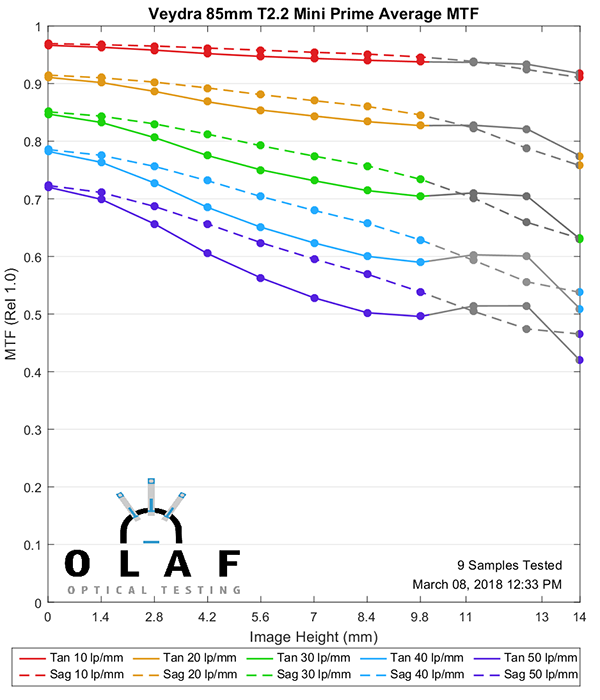
Olaf Optical Testing, 2018
Veydra Mini Prime 50mm T2.2
The 50mm lens has an amazingly high resolution in the center and maintains it very well through the micro 4/3 frame. At the edges of the Super 35 (or APS-C) sensor, there is some fall off, though.
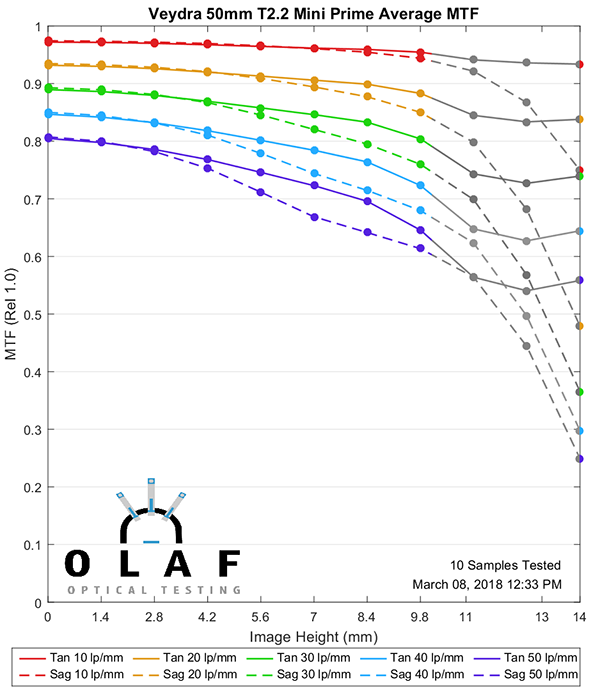
Olaf Optical Testing, 2018
Veydra Mini Prime 35mm T2.2
Again, this is really good performance in the center half of the frame. It fades a little in the outer part of an m4/3 frame and a lot in the outer 1/3 of a Super 35/APS-C frame.
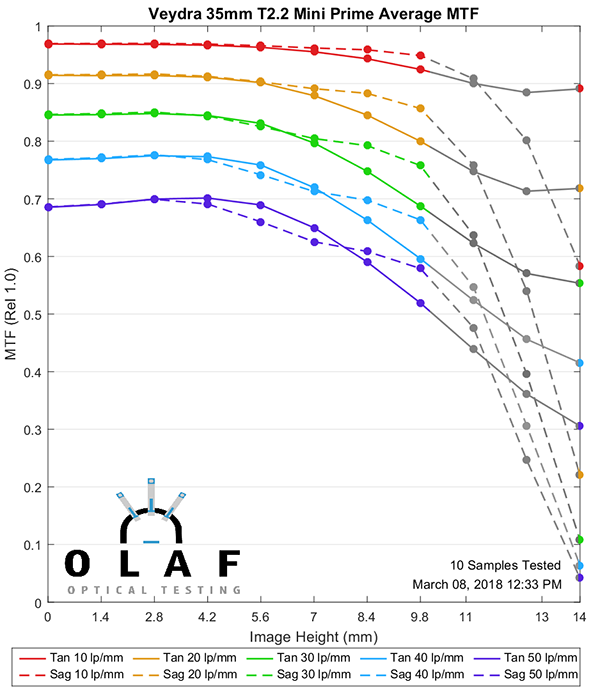
Olaf Optical Testing, 2018
Sensor Glass Effects
I am a geek, which means whenever I think of putting the same lens on different sensors, I worry about the effects of different sensor glass thickness. In this case, the lenses can be used on an m4/3 camera (4mm to 5mm glass thickness) or a Sony camera (2mm glass thickness). In theory, this might, or might not, cause the lenses to have very different MTF away from the center. So for each focal length, we compared m4/3 and E mount lenses, using 4mm glass for the m4/3 and 2mm glass for the E-mount.
Veydra Mini Prime 85mm T2.2
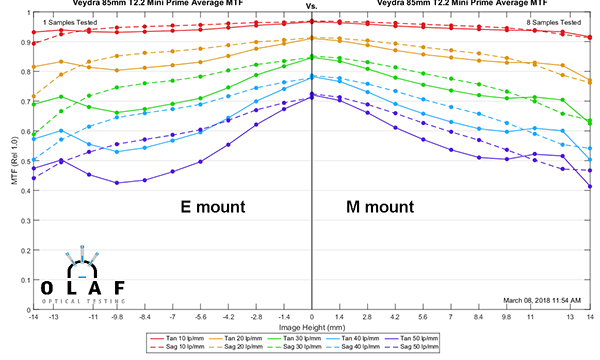
Olaf Optical Testing, 2018
Veydra Mini Prime 50mm T2.2
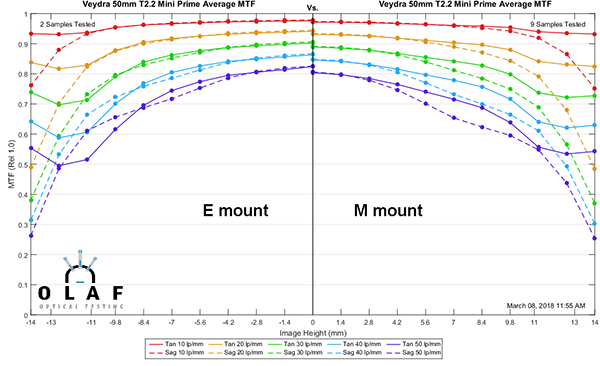
Olaf Optical Testing, 2018
Veydra Mini Prime 35mm T2.2
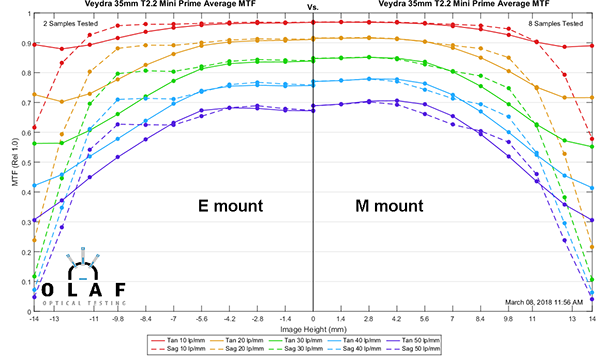
Olaf Optical Testing, 2018
There are some slight differences, but they are not significant for the 50mm and 35mm lenses. There may be a difference in the 85mm results, with increased sagittal-tangential separation off-axis, but it’s very small and could merely be the smaller sample sizes (a few copies each) used in this comparison.
How About Some Comparisons to Other Lenses?
Well, of course! I can’t use my handy computerized comparison tool here because most of the Cinema lenses we’ve tested are done for full-frame lenses. So I’ve done a little cutting and pasting from stock data. It should be adequate to make some comparisons, but remember, the graphs are of different size sensors. If you mounted a FF lens on a micro 4/3 or Super 35 camera, you’d only be using the central portion of the image, so that’s what you should compare. To make that a little easier I’ve gone with the ‘color the graph out to 10mm away from center’ technique I pioneered above.
Compared to Zeiss CP.2 Lenses
If you’re a CP.2 fan, you’re going to have to talk about the look of the lenses, or how they handle, or something similar to explain why you like them. Because, to be quite blunt, the Veydras just kick some serious resolution butt in this comparison. To be fair, though, Zeiss CP.2s have never been about absolute resolution. On the other hand, when you move up to 4k and eventually higher footage, the resolution is going to be more important than it was at 1080p, especially on smaller sensors.
85mm
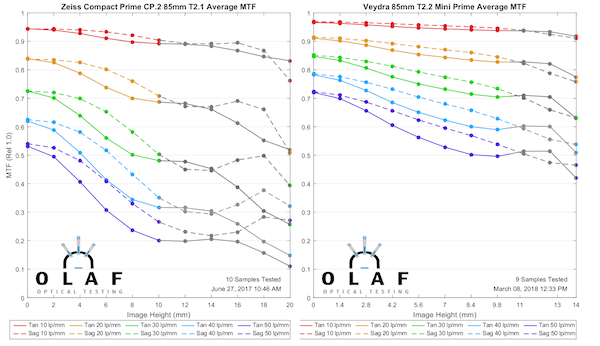
Olaf Optical Testing, 2018
50mm
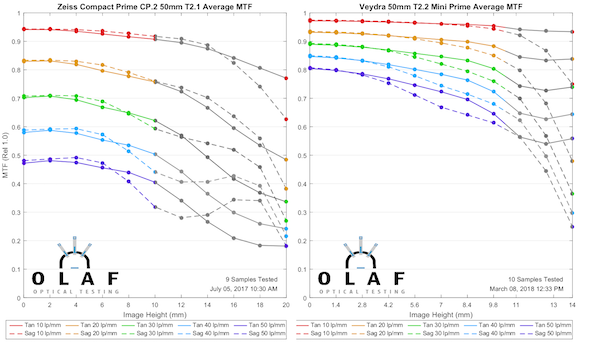
Olaf Optical Testing, 2018
35mm
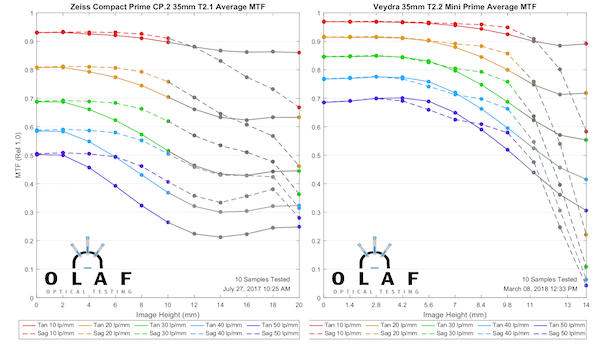
Olaf Optical Testing, 2018
The graphs speak for themselves. If you are shooting on a crop sensor body and want the best resolution, the Veydra’s are simply better. You may well prefer the ‘Zeiss look’ or any of a dozen other factors. But if you want to claim the Zeiss out-resolves the Veydra, you are as incorrect in your preconceived notions as I was before I tested these. Of course, being incorrect never stopped anybody from saying stuff on the internet.
Field Curvature
While most people debate the MTF graphs, the field curvature (MTF vs. Field vs. Focus) graphs give far more practical information. We limited these to the m4/3 range because, well, that’s the range we were testing when we did the field curvature tests. These are single-copies, not the average of all tested copies.
Veydra Mini Prime 85mm T2.2
The overall field is very flat, but if you look closely, there’s a very slight sagittal curve in one direction, with a tangential curve in the other. It’s very mild, though. This particular copy has a slightly tilted field also, which some do, because real lenses, not manufacturer’s claims. This is not something you’d notice in actual use, however.
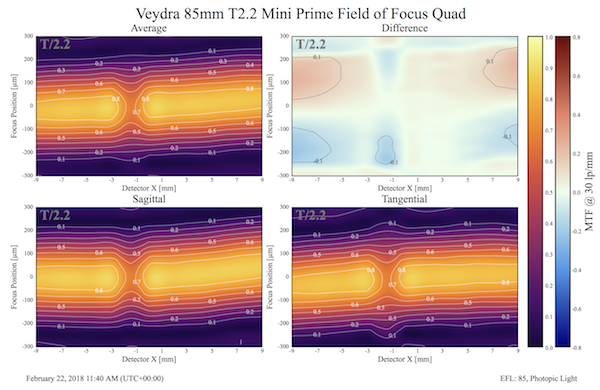
Olaf Optical Testing, 2018
Veydra Mini Prime 50mm T2.2
Because you’ll wonder about it, the little blob at the bottom of this graph is what happens if you get a tiny piece of reflective dust in the optical path of the MTF bench; it’s an artifact of testing a not a real thing. Otherwise, we have a very nice flat field here with just the slightest bit of curve in both fields.
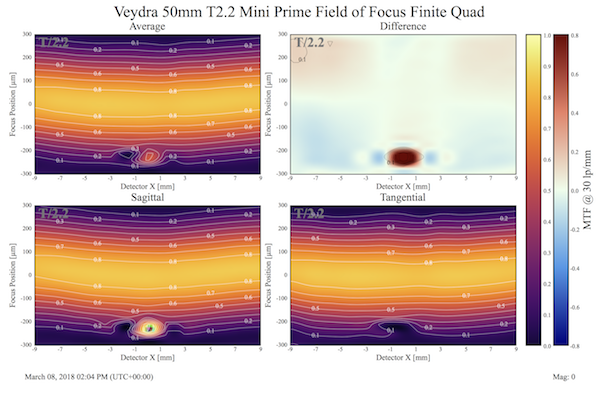
Olaf Optical Testing, 2018
Veydra Mini Prime 35mm T2.2
Field curvature tends to be more apparent in wider lenses, and while there is more curvature in the 35mm Mini Prime, it’s still just moderate for a 35mm lens.
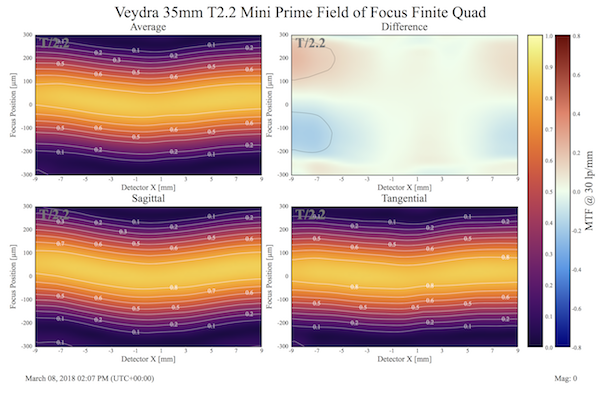
Olaf Optical Testing, 2018
Variance
The catch with the vast majority of less-expensive lenses is usually copy-to-copy variance. I will point out that it’s also an area of personal frustration for me, so I tend to put a lot more emphasis on it than many of you do. People look for that ‘great copy’ of the cheapest lenses with all the effectiveness of Monty Python’s Quest for the Holy Grail.
So, I fully expected to see a lot of variation in the Veydra Mini Primes because that’s what we always see in inexpensive lenses. If you’re sensing a pattern of “Roger’s preconceived impressions were entirely wrong” here, you are correct. The Veydras controlled copy-to-copy variation exceptionally well; far better than that other discount cine lens brand and better than a lot of quite expensive prime lenses. Using our internal variance number the Veydras all rated in the ‘excellent’ range.
Veydra Mini Prime 85mm T2.2
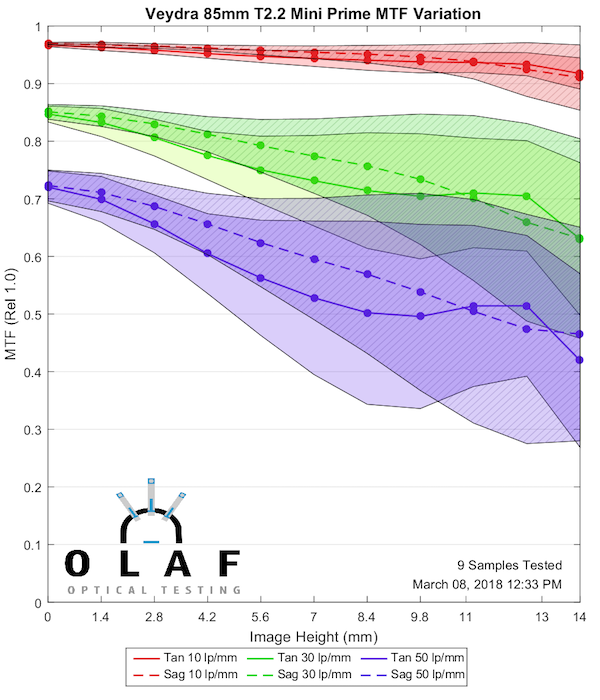
Olaf Optical Testing, 2018
Veydra Mini Prime 50mm T2.2
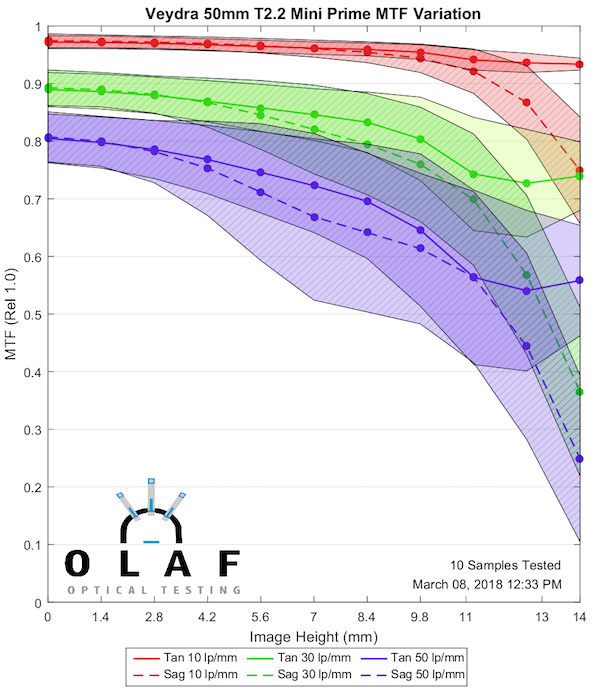
Olaf Optical Testing, 2018
Veydra Mini Prime 35mm T2.2
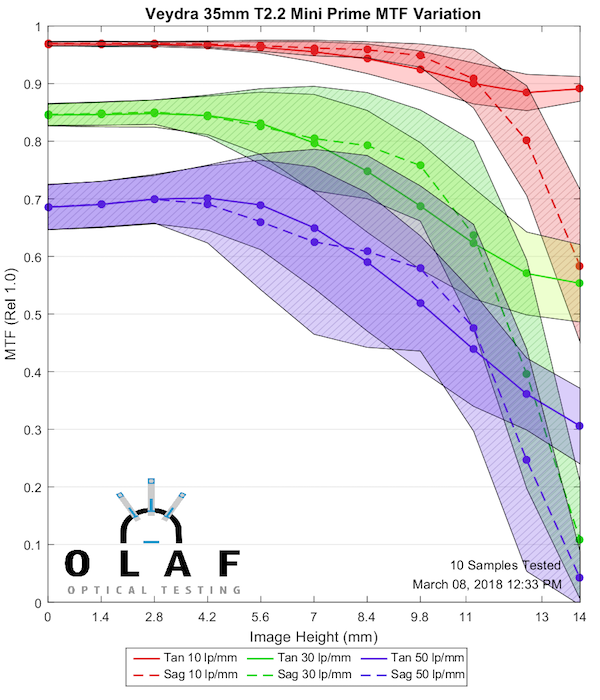
Olaf Optical Testing, 2018
So What Did We Learn Today?
We learned for the umpteenth time that doing scientific testing is a great way to shoot down Roger’s assumptions. We knew the Veydras were conveniently small at a very reasonable price. I was really surprised at how optically excellent they were and even more surprised at how consistent their performance is from on copy to another. These are currently sort of cult lenses that most people don’t consider very often. Most people, as is so often the case, are wrong for that. These are really very good lenses. Emphasis on “really” and “very.”
Roger Cicala and Aaron Closz
Lensrentals.com
March, 2018
Author: Roger Cicala
I’m Roger and I am the founder of Lensrentals.com. Hailed as one of the optic nerds here, I enjoy shooting collimated light through 30X microscope objectives in my spare time. When I do take real pictures I like using something different: a Medium format, or Pentax K1, or a Sony RX1R.
-
Luis Jaime Rodriguez Reynoso
-
Joshua Richardson
